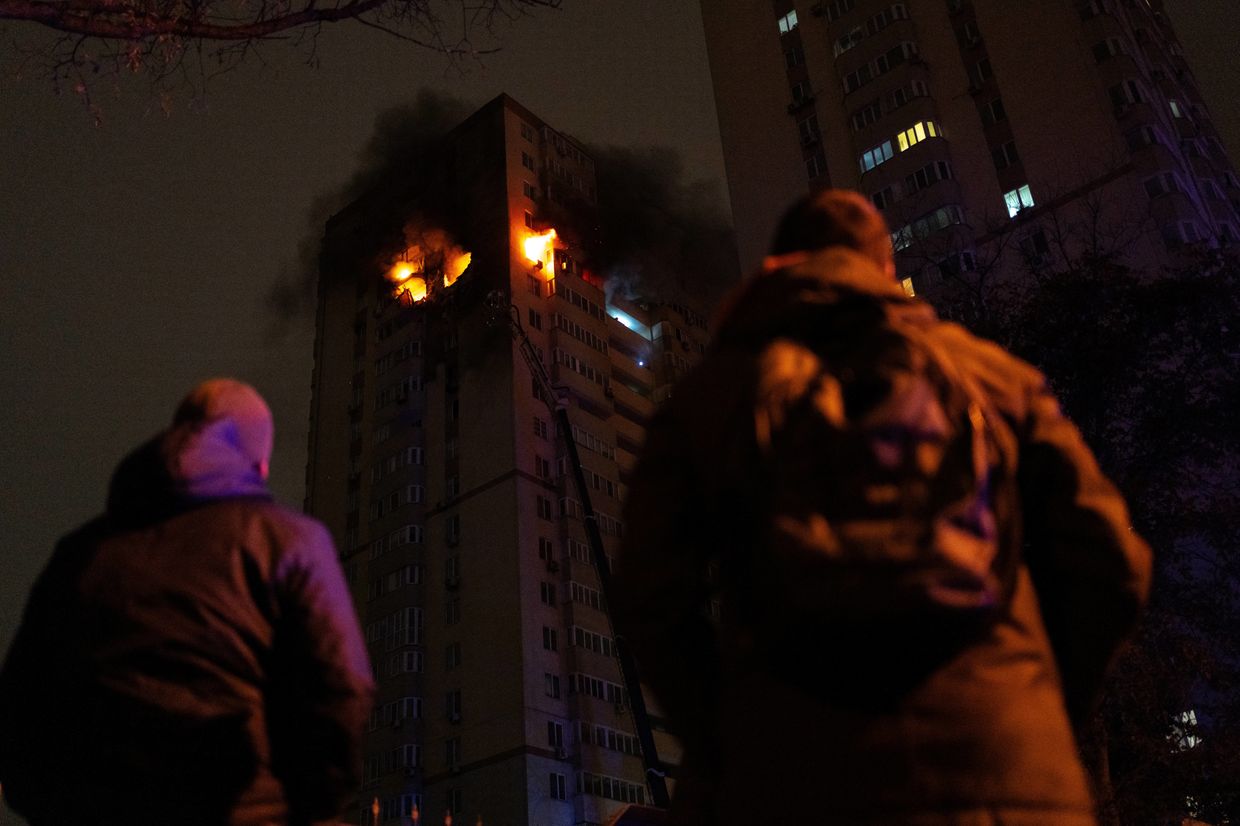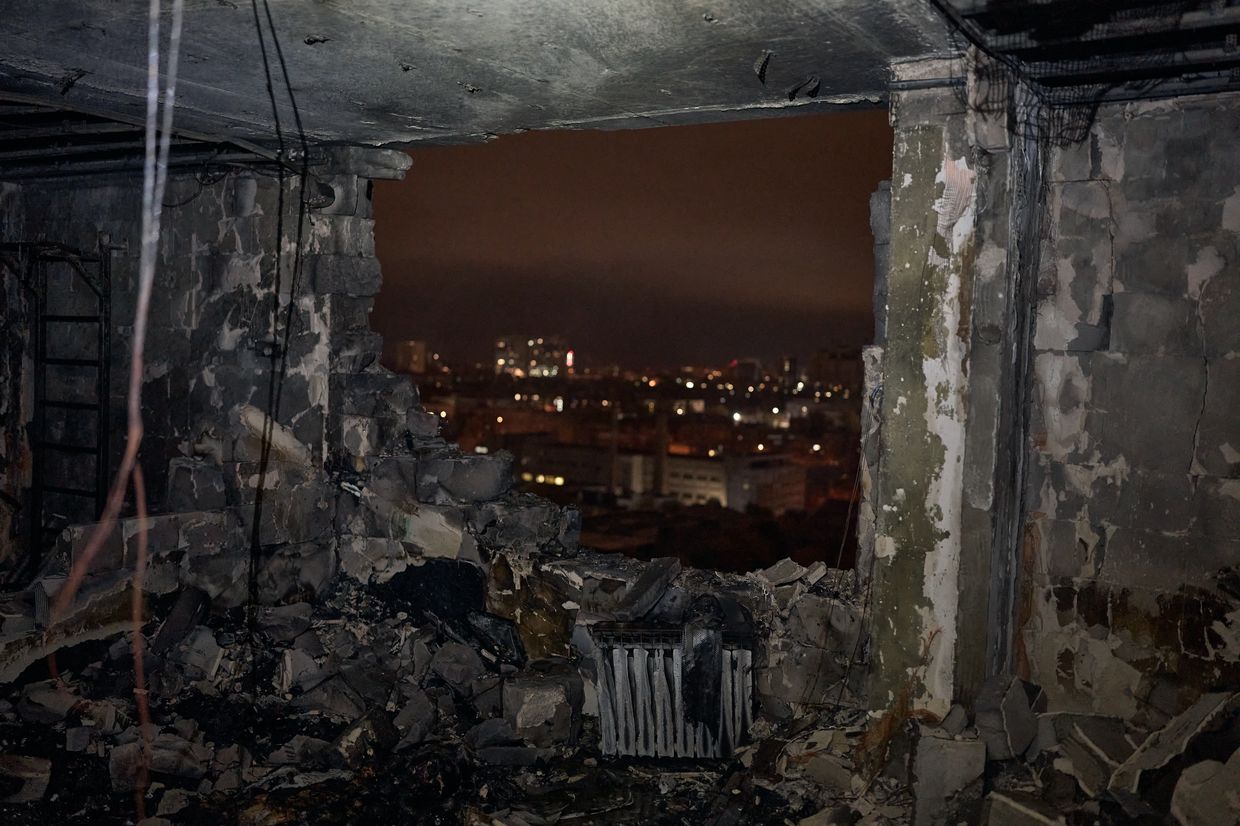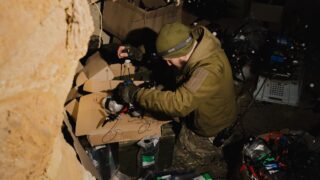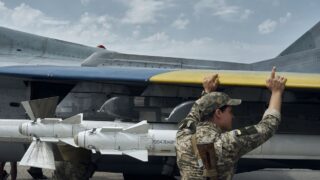
Russian drone strikes surge, passing air defenses even into downtown Kyiv
As Russia launched another swarm of killer drones to attack Kyiv on one day in early November, one of them came dangerously close to Petro, a 55-year-old resident of a high-rise apartment building in downtown Kyiv.
“I saw this motherf*cker just maybe 200 meters above my head, very low. I could see its shape and color. It was black, a triangular shape of the Shahed (drone),” Petro told the Kyiv Independent.
“Machine gunners were trying to hit it from one of the tall buildings. You could see the red traces of bullets … I heard an explosion a couple of seconds after that,” he added.
He was describing one of the latest in a surging wave of Russian drone strikes that are rattling infrastructure, towns, and cities across Ukraine, including – as of late – the very downtown area of the country’s capital.
Petro, whose last name is not being revealed due to his advisory role in Ukraine’s war effort against Russia’s full-scale invasion now in its third year, continued, saying: "A week ago, I saw two of them at the same time. They were a little bit higher than this time.”
The Shahed kamikaze drones he was referring to are designed and built in Iran, an ally of Russia in its war against Ukraine. They have been supplied in large numbers by Tehran to Moscow and account for the majority of Russia’s strike drone capabilities. Russia is also producing them locally on its turf.
“What surprises me is that they make it to the downtown area quite often now. It was a rare occasion earlier in the war, but now it's pretty much every night … so many of them flying at such low altitudes,” Petro said.


He spoke with the Kyiv Independent one day after a Russian drone crashed into the top floor of Jack House, a skyscraper apartment building in Kyiv’s centrally located Pecherskyi District, sending a European diplomat residing there for cover.
“Early yesterday, the building where Estonian ambassador Annely Kolk lives in Kyiv was hit by a Russian drone … She was lucky not to be harmed,” the Estonian Foreign Minister, Margus Tsahna, said in a Nov. 8 post on social media platform X.
“No one is safe in Ukraine until Russia stops its aggression. Ukraine needs more air defense to protect its residents. We must not get used to this,” he added.
Early yesterday, the building where #Estonian amb @AnnelyKolk lives in #Kyiv was hit by a Russian drone.
She was lucky not to be harmed.No one is safe in #Ukraine until Russia stops its aggression. 🇺🇦needs more air defense to protect its residents.
We must not get used to this. pic.twitter.com/bUTz3c5AT6— Margus Tsahkna (@Tsahkna) November 8, 2024
While hearing explosions from drones being intercepted or hitting targets on city outskirts has been a common overnight occurrence in the past two years, hearing their buzzing sound in downtown Kyiv is a sign that they – by their sheer higher numbers – are now getting through multiple layers of air defenses.
President Volodymyr Zelensky said early this week that Russia had launched 500 Shahed-type drones across the country since late October, targeting civilian and critical infrastructure.
GRAPH FROM OF DRONE AND MISSILE STRIKES – KATYA HODUNOVA SHOULD HAVE PUT IT IN ADMINKA ALREADY.
Kyiv faced one of the longest air raids in recent months overnight on Nov. 2. On that Saturday, after a long working week, the Ukrainian capital was under mass drone attack for five hours straight. Although none of the drones hit their target, their debris still caused much damage across the city.
Kyiv among main targets in surging drone attack tactic
The Ukrainian capital has always been one of the most coveted trophies for Russia. Having failed the assault to capture Kyiv at the beginning of the full-scale invasion, Moscow continues to terrorize the city in other ways, including with drones.
The last large-scale missile attack on Kyiv took place back in September, but Russia has changed its tactics and is now depleting Ukraine's air defense with much cheaper unmanned aerial vehicles (UAVs).
Shooting down a drone takes longer as it is not as fast as a missile and can be harder to detect, especially at night. Drones also often maneuver and change altitudes, making it difficult for mobile air defense fire groups and other military units to down them. As a result, air raid alarms can stay on for hours.
"Now they (Russian forces) are using the tactic when Shaheds enter the city at low altitudes, the attacks come in waves," Mykhailo Shamanov, the spokesperson of the Kyiv City Military Administration, said on national television on Nov. 2.
"They (Russian drones) try to circle in certain areas, attracting the attention of mobile fire groups. The main goal is to confuse the air defense forces as much as possible. They try to make mobile groups move, thus creating corridors for the next waves to pass through."
Shamanov added that Russian drones are constantly trying to spy out air defense locations so that the next waves of UAVs can bypass them.

Throughout Nov. 2 and 3, debris from downed Russian drones fell in seven districts of Kyiv, including the city center.
Apart from residential buildings and cars, energy infrastructure in Kyiv and surrounding Kyiv Oblast has been damaged, according to DTEK, Ukraine's largest privately owned energy company. Several buildings were left without electricity.
The grid of Kyivvodokanal, the municipal water supply company, was also damaged, taking about a day to repair it.
On Nov. 3, a nighttime drone attack severly damaged the building of the Institute of Journalism at Taras Shevchenko National University of Kyiv. Due to the incident, students switched to distance learning, at least for the next week.
Ukraine's Air Force told the Kyiv Independent that this is not the first time that Russian attack and reconnaissance drones have reached the center of Kyiv. Since Russian forces are now launching drones by the hundreds, not all of them are intercepted before reaching central Kyiv.
Russian drones are also equipped with alternative means of communication, including satellite ones. Satellite navigation helps to keep the drone under control at a long distance and increase its protection from electronic warfare. The latest Shahed-type drones may also have reconnaissance equipment that can be used for various purposes, according to the Air Force.
The Shahed-type drone is a "serious weapon." Due to its large size, it can fly several kilometers more by inertia when shot down. However, there is no way out — "they are downed wherever they can be downed," the Air Force said.
Sometimes, drones are shot down right over residential areas.


Russia ramps up drone production
"At this point, the biggest advantage that Russia may have in such attacks is sheer numbers of drones," Samuel Bendett, a senior fellow at the Center for a New American Security think tank, told the Kyiv Independent.
Bendett mentioned the Alabuga Special Economic Zone in Russia's Republic of Tatarstan, where a Shahed-type drones plant is located. In May, the Wall Street Journal (WSJ) reported, citing a contract leaked by the Prana Network hacker group, that the factory already produces 4,500 Shaheds annually and aims to increase this number to 6,000.
"It appears that Russian efforts in Alabuga have ensured that the Russian military has thousands such UAVs at its disposal along with other simpler, smaller variance identified recently that fly alongside these official Geran (Russian name for Shahed-type) UAVs," Bendett said.
Taras Rud, a Ukrainian developer of weaponry, including drones, estimated that it costs Russia about $100,000 to produce one Shahed-type drone, adding that it is a "nothing" price tag for the defense industry. In the meantime, Russian forces are trying to force Ukraine to shoot down these cheap air targets with expensive Western-produced missiles.
"The winner is the one who can deliver more explosives from point A to point B in the cheapest way. In the end, it is a war of economies," Rud said.
Russia is seeking to replace aircraft with drones, creating air superiority and depleting Ukraine's air defenses, using aerial dummy targets, among other means. If they are sufficiently drained, Russia will be able to use its large fleet of planes and bombers in the skies over Kyiv, causing even more destruction, Rud added.


According to the expert, the situation may become significantly more complicated if drones start flying at an altitude of 2-3 kilometers (nearly 1 mile) because then most of the cheaper means of shooting them down will no longer be effective. Intercepting them with more expensive and sophisticated air defenses like the U.S.-produced Patriot missiles, which cost several million dollars each, will not be a sustainable option.
Rud also assumed that the Russian military is working to make drones less dependent on GPS signals and able to navigate the territory of Ukraine without them.
"The Russians will accumulate drones. What will they do next? They will launch not 100 drones, but, for example, 500 or 1,000," the expert said.
"And then out of this number, 20 or 30 will fly to Kyiv instead of 2-3 per night."
It’s not entirely clear what Ukraine could do immediately to counter these increasing waves of drone attacks until it gets more air defense systems from Western allies.
Mykhailo Fedorov, Ukraine’s deputy prime minister in charge of innovation and digitization, pointed to efforts underway to improve “situational awareness in the sky, of the enemy's drones, of our drones, and how to react.”
Answering a question from the audience about the drone attacks hitting the capital during the Kyiv International Economic Forum held in the capital on Nov. 7, he described “a system of rapid reaction, which allows analyzing in real-time and seeing what needs to be improved.”
Petro, who witnessed the drone attacks in recent weeks firsthand from the 9th floor of his apartment in downtown Kyiv, said that “we can observe they (Russians) are now producing them in masses.”
“We absolutely need more air defenses.”


















